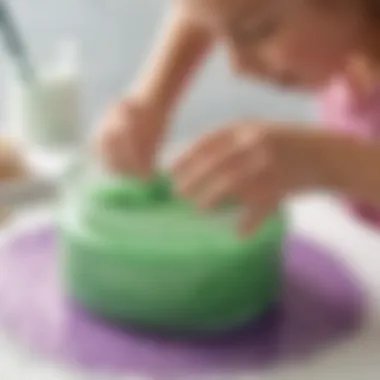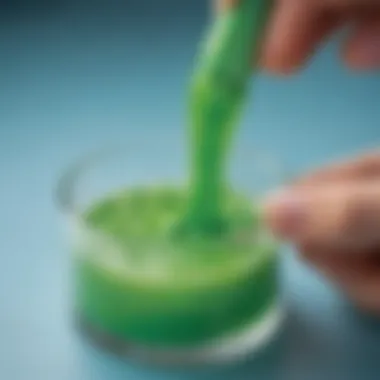Crafting Slime: A Comprehensive Guide for Young Science Enthusiasts


Science Fun Facts
Crafting slime is an enthralling activity that merges fun and learning for young science enthusiasts. By exploring this interactive project, children aged 6-12 can immerse themselves in the captivating world of polymer science. This guide aims to spark curiosity and engage curious minds in hands-on experimentation. Get ready to unravel the wonders of science in a playful and educational way!
Discover the Wonders of Science
Embark on a journey to discover the fascinating scientific concepts behind slime-making. Let's delve into the molecular structure of polymers, explore the principles of viscosity, and unlock the secrets of non-Newtonian fluids. Educational videos and animations will accompany our exploration, shedding light on how slime transitions from a liquid to a solid. Real-life applications of polymer science will also be highlighted, showcasing how this fun experiment relates to everyday materials and substances.
Science Quiz Time
Are you ready to test your scientific knowledge with interactive quizzes and brain teasers? Challenge yourself with multiple-choice questions that will puzzle and intrigue young minds. From exploring the properties of slime to understanding the role of reactants in its formation, these quizzes aim to reinforce learning through gamification. Prepare for a fun and engaging quiz time that will solidify your grasp of scientific principles!
Science Experiment Showcase
Get your lab coat ready for a hands-on science experiment showcase! From colorful slime recipes to glow-in-the-dark variations, we'll provide step-by-step instructions to guide budding scientists through the creation process. A detailed materials list will ensure that you have everything you need for a successful slime-making session. Safety tips and precautions will also be outlined to promote responsible experimentation and ensure a safe scientific exploration.
Introduction to Slime Making
Crafting slime can be a fascinating endeavor for young science enthusiasts aged 6-12, as it not only provides a creative outlet but also offers an opportunity to explore scientific principles in a hands-on manner. By engaging in the process of slime making, children can enhance their understanding of concepts like viscosity, polymers, and chemical reactions. This section serves as a gateway to the world of slime, laying the groundwork for the steps to follow.
Understanding the Basics
Gather the Necessary Ingredients
One fundamental aspect of slime making is gathering the essential ingredients. This includes items like glue, activators such as borax or contact lens solution, and optional add-ins like glitter or beads. The choice of ingredients plays a crucial role in the texture and consistency of the final product. By carefully selecting high-quality materials, young scientists can ensure the success of their slime creations.
Prepare the Workspace
Preparing the workspace is vital to conducting a successful slime-making experiment. A clean and organized environment not only promotes safety but also helps in maintaining focus and efficiency. Setting up designated areas for different tasks, such as mixing and kneading, can streamline the process and prevent cross-contamination of materials. Moreover, having easy access to supplies and tools expedites the crafting process.
Learn about the Science Behind Slime


Understanding the science behind slime adds an educational element to the activity. By learning about the chemical reactions that occur when ingredients like glue and activators interact, children can grasp concepts related to polymers and non-Newtonian fluids. This knowledge not only enhances their scientific literacy but also fosters curiosity and a deeper appreciation for the world of chemistry.
Safety Precautions
Use Protective Gear
Prioritizing safety is paramount when engaging in any scientific experiment, including slime making. Using protective gear such as gloves and goggles can prevent accidental exposure to potentially harmful substances. Additionally, selecting non-toxic ingredients and working in a well-ventilated area further ensures a safe crafting environment for young scientists.
Supervise Children during the Process
Supervision is essential during the slime-making process, especially when young children are involved. An adult or caregiver should oversee the activity to provide guidance, prevent hazards, and intervene in case of emergencies. By supervising children closely, caregivers can facilitate a positive and secure scientific experience for budding chemists.
Creating Your Slime
In this article, the section 'Creating Your Slime' plays a pivotal role in guiding young Science enthusiasts aged 6-12 through the exciting process of making slime. By delving into this section, readers will gain valuable insights into the intricacies of slime creation. Understanding how to select the right recipe, mix the ingredients correctly, and activate the slime is crucial for a successful slime-making experience. Not only does this section encourage hands-on experimentation, but it also fosters an understanding of the scientific principles underlying slime formation, promoting a holistic learning environment for budding scientists.
Choosing the Right Recipe
Selecting a Borax-Based Recipe
The choice between a borax-based or borax-free recipe is a critical decision when creating slime. Opting for a borax-based recipe offers a tried-and-true method for producing high-quality slime. Borax, a natural mineral, serves as an excellent cross-linking agent that helps bind the ingredients together effectively. Its adhesive properties result in a stretchy and pliable slime consistency, ideal for sensory play and fun experimentation. However, some individuals may prefer an alternative to borax due to safety concerns or skin sensitivities.
Opting for a Borax-Free Recipe
On the other hand, selecting a borax-free recipe provides a safe and accessible option for creating slime. Ingredients such as liquid starch, contact lens solution, or baking soda can serve as suitable substitutes for borax. These alternatives still deliver a satisfying slime texture while eliminating the need for potentially harsh chemicals. Choosing a borax-free recipe is ideal for individuals seeking a safer slime-making experience or those looking to explore different avenues of creating slime.
Mixing the Ingredients
Combining Glue and Water
When mixing the ingredients for slime, combining glue and water forms the foundation of the slime mixture. Glue acts as the primary binding agent, while water helps achieve the desired consistency. The ratio of glue to water is crucial in determining the slime's texture, whether it's slimy, firm, or stretchy. Through proper mixing techniques, such as stirring slowly and evenly, you can ensure a smooth and uniform distribution of the ingredients. This step sets the stage for incorporating additional elements, like coloring and glitter, to customize your slime further.


Adding Coloring and Glitter
Enhancing your slime with coloring and glitter adds a creative and aesthetic dimension to the final product. Color pigments not only transform the visual appeal of the slime but also provide an opportunity for sensory exploration through vibrant hues. Glitter, on the other hand, introduces sparkle and texture, making the slime visually engaging and exciting to play with. By carefully adding coloring and glitter to the mixture, you can personalize your slime to reflect your unique preferences and style.
Activating the Slime
Incorporating Activators
Activators, such as borax solution or saline solution, play a crucial role in activating the slime's polymer chains and transforming the mixture into a cohesive substance. The activator interacts with the glue molecules, causing them to link together and form long chains, resulting in the characteristic slime texture. Incorporating the right amount of activator is essential to achieving the desired slime consistency, whether you prefer a stretchy, fluffy, or crunchy slime variation. Experimenting with different activators allows for customized slime outcomes tailored to individual preferences.
Kneading and Testing the Consistency
Once the activator is added, kneading the slime mixture is paramount to ensure uniform activation and consistency. Kneading facilitates the bonding of ingredients, resulting in a smooth and stretchable slime texture. Testing the consistency by pulling, stretching, and squishing the slime provides valuable feedback on its readiness. Adjustments can be made during this phase to achieve the perfect balance of elasticity and viscosity in the slime. Regularly kneading and testing the slime ensures a satisfactory sensory experience and long-lasting playability.
Customizing Your Slime
When delving into the enchanting world of slime-making, customizing your slime opens up a realm of creativity and personalization. It plays a pivotal role in enhancing the overall slime-making experience, allowing individuals to express their unique style and preferences. You can experiment with a myriad of add-ins, textures, and scents to tailor your slime to your liking. Customizing your slime not only fosters creativity but also encourages scientific exploration through trial and error, observing how different additives impact the slime's properties. This aspect of the article shines a spotlight on the significance of personal expression and scientific curiosity in the process of crafting slime, providing young science enthusiasts with a platform to unleash their imagination and delve into the fascinating world of hands-on experimentation. The section on Customizing Your Slime serves as a gateway to a world of endless possibilities, where young minds can explore, create, and discover the magic of science through a fun and interactive activity.
Experimenting with Add-Ins
Diving deeper into the realm of customizing slime, the subsection on Experimenting with Add-Ins introduces young scientists to a playground of options to elevate their slime-making experience. Within this subsection, three key aspects are explored, each offering a unique twist to traditional slime recipes. From adding foam beads to mixing in glitter or sequins, and including scented oils, each add-in introduces a new dimension to the texture, appearance, and sensory experience of the slime. Emphasizing experiential learning, these add-ins not only enhance the aesthetic appeal of slime but also prompt young enthusiasts to observe the transformative effects of various materials in a tangible, hands-on manner. By engaging in these additive experiments, children can grasp fundamental scientific concepts such as material properties, solubility, and chemical interactions in a playful and immersive setting, igniting their passion for discovery and experimentation.
Adding Foam Beads
Introducing foam beads into the slime mixture elevates the tactile experience by adding a satisfying crunch and texture to the final product. These colorful and lightweight beads create a unique sensory experience, making the slime more engaging to touch and manipulate. The key characteristic of foam beads lies in their ability to retain their shape and buoyancy within the slime, creating a delightful popping sensation as they are compressed and released. This sensory feedback not only enhances the interactive nature of slime but also encourages proprioceptive input, stimulating sensory processing and fine motor skills in young learners. The unique feature of foam beads enhances the play value of slime, providing a multisensory experience that promotes sensory exploration and imaginative play.
Mixing in Glitter or Sequins
The addition of glitter or sequins introduces a sparkly touch to slime, transforming it into a dazzling and visually appealing creation. By incorporating these shimmering elements, children can customize their slime with a touch of glamour and sparkle, creating a magical aesthetic that captivates the eye. Glitter and sequins reflect light and color, enhancing the visual appeal of the slime and creating a mesmerizing effect as the slime is kneaded and stretched. The key characteristic of mixing in glitter or sequins lies in their ability to add a visual flair to the slime, turning it into a glamorous sensory experience. This enhancement not only delights the senses but also encourages creativity and self-expression, as young enthusiasts design slimes that reflect their unique personalities and style.
Including Scented Oils


Infusing slime with scented oils introduces a delightful olfactory dimension to the sensory experience, engaging not only touch but also the sense of smell. By selecting scented oils with captivating fragrances, such as fruity, floral, or sweet scents, children can customize their slime with pleasing aromas that evoke different moods and sensations. The key characteristic of scented oils lies in their ability to create a curated sensory experience, where the aroma adds an extra layer of engagement and immersion to the slime-making process. This sensory enhancement not only stimulates the sense of smell but also promotes relaxation, mindfulness, and emotional well-being through aromatherapy principles. The inclusion of scented oils in slime enriches the overall sensory exploration, turning the activity into a sensorial delight that engages multiple senses and promotes holistic well-being.
Storing and Maintaining Your Slime
Upon creating the perfect customized slime, the subsection on Storing and Maintaining Your Slime guides young enthusiasts on how to preserve their creations for lasting enjoyment. Proper storage techniques are essential to prevent the slime from drying out or becoming contaminated, ensuring that it retains its texture and properties over time. By observing specific storage practices, such as sealing the slime in airtight containers or avoiding exposure to direct sunlight, children can prolong the lifespan of their slime and continue to enjoy its sensory delights. Additionally, the subsection explores tips for maintaining the slime's shelf life, addressing common pitfalls and providing practical strategies to keep the slime fresh and usable. By following these guidelines, young slime-makers can maximize the longevity of their creations and sustain the magic of their customized slimes for extended play and experimentation.
Proper Storage Techniques
Proper storage techniques are critical in preserving the quality and longevity of slime, safeguarding it against environmental factors that could compromise its texture and consistency. By storing slime in airtight containers or resealable bags, children can protect it from exposure to air and moisture, preventing undesired evaporation and maintaining its stretchiness and pliability. Properly sealed containers also shield slime from external contaminants, such as dust or dirt, ensuring that it remains clean and safe for play. The key characteristic of proper storage techniques lies in their role in maintaining the slime's freshness and integrity, enabling young enthusiasts to enjoy their creations repeatedly without worrying about deterioration. This preservation method not only prolongs the lifespan of slime but also cultivates a sense of responsibility and organization in children, teaching them the importance of proper care and maintenance of their scientific creations.
Tips for Prolonging Slime's Shelf Life
In addition to storage practices, implementing specific tips for prolonging slime's shelf life can further enhance the durability and usability of the slime. By avoiding exposure to extreme temperatures and humidity, children can prevent slime from melting or becoming too stiff, preserving its desirable texture for prolonged enjoyment. Furthermore, instructing young slime-makers to wash their hands before playing and using slime on clean surfaces helps prevent contamination and maintains slime cleanliness. Providing tips on kneading slime regularly to redistribute moisture and prevent potential breakage also contributes to preserving its malleability and playability over time. The key characteristic of tips for prolonging slime's shelf life lies in their practicality and effectiveness in safeguarding the quality of the slime, offering simple yet valuable strategies for maintaining its optimal condition. By following these tips, children can prolong the lifespan of their slime creations, ensuring continued enjoyment and exploration in the realm of scientific discovery and sensory play association.
Exploring Further Science Experiments
When delving into the realm of slime-making, it's crucial to explore further science experiments. By investigating different variations of slime, enthusiasts can deepen their understanding of the underlying scientific principles. This section serves as a gateway to expanding knowledge and fostering a sense of curiosity and experimentation among young science enthusiasts. Exploring further science experiments within the context of slime creation provides an avenue for hands-on learning and application of scientific concepts in a fun and engaging manner. Through experimentation and exploration, individuals can discover the diversity and complexity of slime compositions, paving the way for innovative discoveries and creative concoctions.
Investigating Slime Variations
Creating Fluffy Slime
Creating fluffy slime introduces a unique texture variation that captivates young science enthusiasts. The key characteristic of fluffy slime lies in its light and airy composition, offering a tactile experience that differs from traditional slime textures. Fluffy slime's appeal lies in its non-sticky and moldable nature, ensuring a mess-free and entertaining sensory play session. By incorporating shaving foam or similar additives, fluffy slime embodies a velvety softness that enhances the sensory satisfaction of the slime-making process. While fluffy slime provides an exciting tactile experience, its airy texture may require adjustments to the slime recipe to achieve the desired consistency, adding a layer of experimentation to the crafting process.
Designing Crunchy Slime
Designing crunchy slime introduces a contrasting tactile element that adds an exciting twist to the slime-making experience. The key characteristic of crunchy slime lies in the incorporation of crunchy add-ins such as beads or sequins, creating a satisfying crunch upon manipulation. Crunchy slime's appeal stems from its interactive nature, offering a multisensory experience that enhances play and exploration. The unique feature of crunchy slime lies in its auditory component, as the added elements produce a distinctive sound that adds an extra dimension to the sensory experience. While designing crunchy slime brings an engaging element to slime play, careful consideration is necessary to balance the slime's texture and ensure the additives do not overpower the overall consistency, providing a harmonious blend of tactile sensations.
Learning Through Play
Engaging in Sensory Play with Slime
Engaging in sensory play with slime provides a hands-on learning experience that stimulates multiple senses. The key characteristic of sensory play with slime is its ability to promote sensory exploration and tactile awareness in children. Through sensory play, individuals can engage in open-ended experimentation, encouraging creativity and self-expression. The unique feature of sensory play with slime lies in its therapeutic benefits, offering a calming and relaxing activity that promotes focus and sensory integration. While sensory play with slime offers a sensory-rich experience, supervision is essential to ensure safe and appropriate play, fostering a positive and enriching sensory play environment.
Conducting Simple Chemical Reactions
Conducting simple chemical reactions with slime adds an educational component to the slime-making process. The key characteristic of conducting simple chemical reactions is the integration of scientific principles into hands-on experimentation. By observing color changes or transformations in slime consistency, participants can gain insights into chemical reactions in a simplified and engaging manner. The unique feature of conducting simple chemical reactions with slime lies in its ability to demystify scientific concepts and promote scientific inquiry among young enthusiasts. While conducting chemical reactions adds an educational dimension to slime play, care must be taken to use safe and age-appropriate materials, ensuring a secure and educational scientific exploration for all participants.







